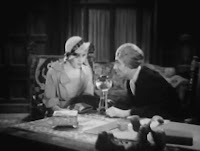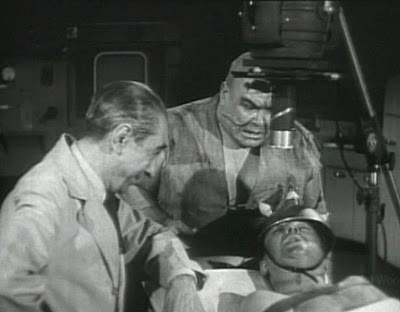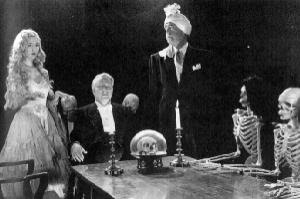Some twenty years before DC Comics and Warner Bros. tumbled to the idea of marketing comics for mature readers ("mature" here meaning adults, interested in reading about adult subject matters that might be treated in serious literature, not porn), writer Steve Gerber was creating comic book tales that in many ways were more mature than the later material labled as such.
Those adults who discovered Gerber's work loved it. His stories featured three dimensional characters who battled real-world issues and real-world problems in addition to super-villains, demons, and nameless horrors from dimensions that would have scared the heck out of Lovecraft and Howard. His stories dealt timeless social and emotional issues and most of them are as relevant and fresh today as they were when they were penned 35-40 years ago.
Unfortunately, comic book readers don't really WANT to read stories that are truly written for adults, so time and again, Gerber's titles were cancelled... a fate that would follow his comics career right up until the bitter end when his truly excellent books for DC Comics, "Nevada" and "Hard Time" failed to find a large enough audience to warrant their continued publication.
Steve Gerber passed away two years ago, but his work is still here for us to enjoy. Over the past three or so years, Marvel Comics has most of Gerber's best work easily acessesible in the low-cost, massive volumes that are part of their "Essential" series. In fact, his work is easier to read not just because you'll have it collected in one spot, but because the printing quality is better and you'll actually be able to read the text-heavy pages in some of the issues. (It's still on news-print, and the ink is still prone to smearing, but it's still clearer.
It's interesting to me that Gerber wrote horror so well, as he has stated that didn't particularly care for horror stories and that he liked monsters even less. Perhaps his is why his horror stories deal with real horrors more than supernatural ones. bigotry, racism, religious extremism, broken dreams, unrealistic expectations, the ugliest manifestations of addiction, poverty, sexual abuse, censorship, politics, depression, suicide, environmentalism... all of these thing are explored in the "Man-Thing" stories that Gerber wrote, oftentimes explored with such thoughtfulness and presented through such well-done characters that almost feel as if what you're reading is too good to be mere comic books.
Gerber was writing comics that were ahead of their time, and he was writing about timeless subjects. Some of the trappings of the tales are a little dated--such as typical early 1970s hippies and biker-types--but the stories and the characters themselves are as relevant and vital as they now as they were when they were first published. If you enjoy intelligent, well-written horror tales, particularly ones that easily mixes straight-forward social commentary with satire and allegory.
Essential Man-Thing, Vol. 1 (Marvel Comics)
Writers: Steve Gerber, Gerry Conway, Roy Thomas and Tony Isabella
Artists: Mike Ploog, Val Mayerik, John Buscema, Gray Morrow, Frank Chiaramonte, Tom Sutton, et.al.
Rating: Nine of Ten Stars
"Essential Man-Thing" Vol. 1 opens with the Man-Thing earliest appearances, chroniclally the events that lead to chemist Ted Sallis being transformed into a mindless creature made of mud and vegetation from a patch of the Everglades. After a couple of adventures that teamed Man-Thing with S.H.E.I.L.D and Marvel's answer to Tarzan, Ka-Zar, against the sinister criminal organization A.I.M, we get the first glimpse of the greatness that is to come.
In a story written by Man-Thing's co-creator Gerry Conway, we learn that Man-Thing has a very strong empathic sense and that he is drawn to emotional and physical pain and misery. We also learn that fear and anger cause him pain and cause him to lash out at the source of that pain, attempting to destroy it with a supernatural ability that causes anything that feels fear to burst into flames when he touches it.(And, as probably goes without saying, most people who come face-to-face with a 7-foot-tall mud-encrusted monster with huge red eyes will fear plenty of fear... so there plenty of people who suffer lethal third-degree burns as a result of an encounter with Man-Thing.)
Although Roy Thomas and Gerry Conway created Man-Thing, it is Steve Gerber who will use the creation to its fullest potential, using Man-Thing's empathic sense to have him drawn to all sorts of situations charged with negative human emotion, thus making him a vehicle for telling stories dealing with topics as diverse as bigotry, jealousy, greed, depression and suicide.

Gerber also added the Kale family, a family of sorcerers living at the edge of the swamp in Citrusville... and in doing so, he set the stage to reveal that Man-Thing and his swamp are guardians of the Nexus of All Realities, thus giving him a free hand to include all sorts of cosmic and extestial elements to his Man-Thing yarns. Finally, he added the character of Richard Rory, a down-on-his-luck Everyman who sort of serves as a stand-in for the reader as the takes unfold; he's a kindhearted, decent and completely normal guy--well, except for having a giant swamp creature as a friend.
The mix of tales in "Essential Man-Thing" Vol. 1 move from small-scale, stories of personal horror to cosmos-spanning, reality-shattering dark fantasy adventures--one often leading to the other and back again--and each is more fascinating than the one before.
There are three main plot threads that run through the book, so, although it's very obvious the 500+ pages were originallty published in chunks of 12 or 22 pages because each presents a finite episode, you'll still feel as if you're reading something that was intended to read as a coherent whole.
The first thread deals with Jennifer Kale's maturation into a sorceress and inheriting her family's duty to help protect the Nexus of All Realities. Jennifer and her extra-dimensional teacher, Dakhim the Enchanter, become the wellspring of all sorts of cosmic nightmares for Man-Thing and those who enter his swamp.
The second thread deals with construction baron and real estate tycoon F.A. Schist (not one of Gerber's most subtley named characters) and his efforts to first drain the swamp to build an airport and later gain revenge upon the Man-Thing for ruining his business. After Schist comes to a very bad and very final end, his family picks up the revenge quest. The Schist storyline is used to explore such diverse topics as environmentalism, bigotry, the dangers of excessive greed, and the self-destructive nature of obsession. Although Schist more often than not comes across as a cartoonish villain, most characters around him are quite three dimensional and even Schist has a few moments of depth.
The third thread deals with Richard Rory's ongoing attempts to make a new life for himself in Citrusville while trying to deal with all the crazy and nightmarish situations he is drawn into. He is a recurring secondary character for most of this book, but his important grows as it wears on, and in Volume 2, he takes center stage for real.
The three story threads weave in and out of each other and the various stand-alone episodes present in the book, giving it a unified feel, a feel that is made stronger by the fact that the final comics story presented in the book harkens back to the very first Man-Thing tale, as it resolves the fate of Ellen Brandt, the woman whose treachery led to Ted Sallis becoming the Man-Thing.
Between the two end pieces and the three running plots, readers are treated some of the most interesting stories Gerber ever wrote, such as "Night of the Laughing Dead", a tale of depression, suicide, and cosmic balance; and the two-part introduction of the Fool-Killer, a tale of religious fanaticism and vigilantism that was written partly as a spoof of the popular Marvel Comics character the Punisher.
And Gerber's Man-Thing stories continue to get better with time, with more greatness following in "Essential Man-Thing" Vol. 2.
It's not just the writing in the book that's so remarkable. We're treated to some great art from Mike Ploog (whose Will Eisner-inspired style lends itself perfectly to the water-logged Everglades swamp where most of the stories take place), Val Mayerik, and John Buscema. There are other minor contributors, but those three gentlemen produce some truly gorgeous pages. (Mayerik's art suffers a little bit due to the lack of colors in this black-and-white reprint volume, but Ploog and Buscema's art shines.)
"Essential Man-Thing" Vol. 1 is a book bursting with true classics of the comics genre. It's a must-own for affeciandos of the genre, or for anyone who loves intelligent, well-written horror tales.
 Essential Man-Thing, Vol. 2 (Marvel Comics)
Essential Man-Thing, Vol. 2 (Marvel Comics)
Writers: Steve Gerber, Chris Claremont, Mike Friedrich, Marv Wolfman, J.M. DeMattias and Dickie McKenzie
Artits: Jim Mooney, Don Perlin, Bob Wiacek, John Buscema, John Byrne, Tom Sutton, et. al
Rating: Seven of Ten Stars
"Essential Man-Thing" Vol. 2 picks up where Vol 1 left off, finishing out the first "Man-Thing" series and the rest of the original Man-Thing stories penned by Steve Gerber.
Like the first volume, the tales mix episodic horror with social commentary and satire. The cosmic nature of the stories has mostly been dailed back with storylines about alienation, bigotry and censorship. The mystic Kale family has stepped into the background while hardluck case Richard Rory and some very darkhearted but seemingly-average citizens of Citrusville become the focus of the ongoing storylines. Gerber starts cranking up the cosmic madness in the tales that orginally appeared in "Man-Thing" #20 and #21, but the full scope of the story he was trying to tell, Marvel pulled the plug on the title. However, Gerber made lemonade with the lemons, and the final issue of the series summarized a story that might have spanned three or four issues within a tale that featured Gerber himself as a character and brought the series to a conclusion unlike any other that had previously been seen. Few titles that are cancelled go out on such a high note as "Man-Thing" did.
The Gerber material takes up about half the book,and once it's done, there's a very steep drop in quality.
First off, a bad editorial decision was made to include the team-up between Man-Thing, Captain America and the Thing from "Marvel Two-In-One", as it is a fragment of a much larger storyline and makes little sense on its own when they should have included "Giant-Sized Spider-Man" #5, which detailed Spider-Man's first meeting with Man-Thing and to which the story reprinted from "Marvel Team-Up" #68 is a sequel and makes frequent reference to that previous tale.
Secondly, when Marvel gave Man-Thing another shot at his own title in 1979, with Michael Fleisher and Chris Claremont handling the writing chores, the book was a pale imitation of the first Man-Thing series. Fleisher and Claremont tried to copy Gerber's style, and they failed at every turn, turning in ten issues of suspense comics that are barely above average in quality. To make matters worse, the majority of the issues were illustrated by the team of Don Perlin and Bob Wiacek, competent artists but whose styles are too streamlined and clean to effectively captaure Man-Thing and the vine-choked swamp he dwells in.
Altough not as "essential" as the first volume of "Essential Man-Thing", this book is still well-worth owning for anyone who likes intelligently written horror comics.
(For your information, another Steve Gerber horror milestone was collected two years ago in "Essential Tales of Zombie". I recommend that book as highly as I do the "Essential Man-Thing" volumes.
Click here to read that review.)




























.jpg)
